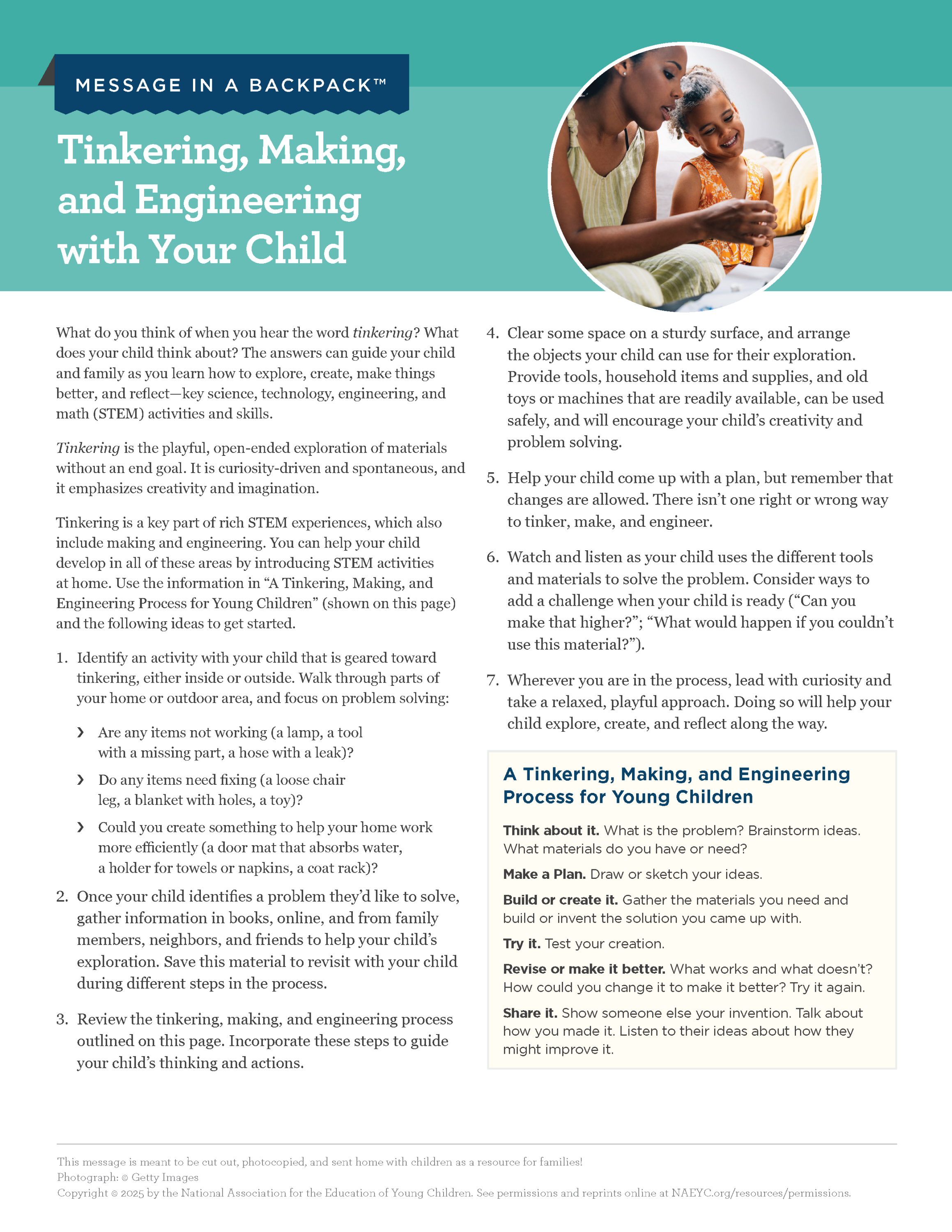Message in a Backpack™. Tinkering, Making, and Engineering with Your Child

You are here
What do you think of when you hear the word tinkering? What does your child think about? The answers can guide your child and family as you learn how to explore, create, make things better, and reflect—key science, technology, engineering, and math (STEM) activities and skills.
Tinkering is the playful, open-ended exploration of materials without an end goal. It is curiosity-driven and spontaneous, and it emphasizes creativity and imagination.
Tinkering is a key part of rich STEM experiences, which also include making and engineering. You can help your child develop in all of these areas by introducing STEM activities at home. Use the information in "A Tinkering, Making, and Engineering Process for Young Children" (shown below) and the following ideas to get started.
1. Identify an activity with your child that is geared toward tinkering, either inside or outside. Walk through parts of your home or outdoor area, and focus on problem solving:
- Are any items not working (a lamp, a tool with a missing part, a hose with a leak)?
- Do any items need fixing (a loose chair leg, a blanket with holes, a toy)?
- Could you create something to help your home work more efficiently (a door mat that absorbs water, a holder for towels or napkins, a coat rack)?
2. Once your child identifies a problem they’d like to solve, gather information in books, online, and from family members, neighbors, and friends to help your child’s exploration. Save this material to revisit with your child during different steps in the process.
3. Review the tinkering, making, and engineering process outlined on this page. Incorporate these steps to guide your child’s thinking and actions.
4. Clear some space on a sturdy surface, and arrange the objects your child can use for their exploration. Provide tools, household items and supplies, and old toys or machines that are readily available, can be used safely, and will encourage your child’s creativity and problem solving.
5. Help your child come up with a plan, but remember that changes are allowed. There isn’t one right or wrong way to tinker, make, and engineer.
6. Watch and listen as your child uses the different tools and materials to solve the problem. Consider ways to add a challenge when your child is ready (“Can you make that higher?”; “What would happen if you couldn’t use this material?”).
7. Wherever you are in the process, lead with curiosity and take a relaxed, playful approach. Doing so will help your child explore, create, and reflect along the way.
A Tinkering, Making, and Engineering Process for Young Children
Think about it. What is the problem? Brainstorm ideas. What materials do you have or need?
Make a Plan. Draw or sketch your ideas.
Build or create it. Gather the materials you need and build or invent the solution you came up with.
Try it. Test your creation.
Revise or make it better. What works and what doesn’t? How could you change it to make it better? Try it again.
Share it. Show someone else your invention. Talk about how you made it. Listen to their ideas about how they might improve it.

Download this Message in a Backpack™ here!
Photograph: © Getty Images
Copyright © 2025 by the National Association for the Education of Young Children. See permissions and reprints online at NAEYC.org/resources/permissions.